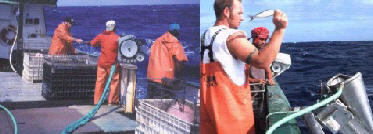|
Longline method may help prevent albatross hookings
By Jan TenBruggencate
Science Writer
Honolulu Advertiser
15th October 2003
A new longline fishing technique called side-setting appears to markedly reduce the problem of albatross grabbing baited hooks and becoming hooked themselves while longline gear is being set.
"It almost eliminates it," said Paul Dalzell, senior scientist with the Western Pacific Regional Fishery Management Council.
A report on the new technique is being presented this week to the council’s Scientific and Statistical Committee, which is meeting in Honolulu through tomorrow. The committee could adopt the new technique, and recommend it be added to the several methods longliners use to reduce their bird catch, Dalzell said.
The committee will also be looking at the more serious problem of turtles being hooked by longline gear - more serious because while Laysan and black-footed albatrosses are plentiful, most sea turtles are threatened or endangered, and some scientists say longlining is a significant threat to their survival.
A federal district judge in Washington, D.C., has given the longline industry and regulators until April 1, 2004, to come up with a regulatory scheme that protects turtles while allowing longlining.
The Western Pacific Council has suggested a regulatory framework to change the kinds of baits used and the kinds of hooks longliners use, in hopes of reducing the turtle catch in the swordfish fishery. Those recommendations could become part of a system that will be put in place April 1.
The Hawai'i longline fleet is prohibited from setting fishing gear for swordfish under the regulations that are in place until April 1. They continue to be able to fish for tuna, for which the fishing gear is set in much deeper water.
"Tuna gear hardly catches any turtles," Dalzell said.
The new bird interaction study shows that the fishing industry has found no technique to reduce turtle bycatch that is nearly as effective as side-setting seems to be.
In traditional longlining, the baited hooks and line are fed off the stern of the fishing boat, and albatross often dive on the bait, entangling or hooking themselves before the gear is drawn into deep water. Side setting uses the side of the boat to shield the fishing gear from the albatrosses until the bait sinks.
"The hypothesis is that when side setting, baited hooks will be set close to the side of the vessel hull where seabirds will be unable or unwilling to attempt to pursue them, and by the time the stern passes the hooks, hooks will be too deep for seabirds to see or reach them," said the authors of the report: "Performance assessment of underwater setting chutes, side setting, and blue-dyed bait to minimize seabird mortality in Hawai'i longline tuna and swordfish fisheries."
The report was prepared by Eric Gilman of the National Audubon Society, marine ecology and technology consultant Nigel Brothers, Donald Kobayashi of the National Marine Fisheries Service, Sean Martin and Jim Cook of the Hawai'i Longline Association and Jerry Ray, George Ching and Barry Woods from the fishing vessel Katy Mary.
They found that side setting was far better than using underwater parachutes or dyed bait in cutting the impact on seabirds. Converting a fishing boat to side setting is not too expensive, and there is no additional cost once it’s in place.
Please see:
Performance Assessment of Underwater Setting Chutes, Side Setting, and Blue-Dyed Bait to Minimize Seabird Mortality in Hawaii Longline Tuna and Swordfish Fisheries - August 2003 (pdf - 666KB)
Streamer Lines to Reduce Seabird Bycatch in Longline Fisheries 2000 - October 2003 update
(pdf - 102KB)
Top
|
